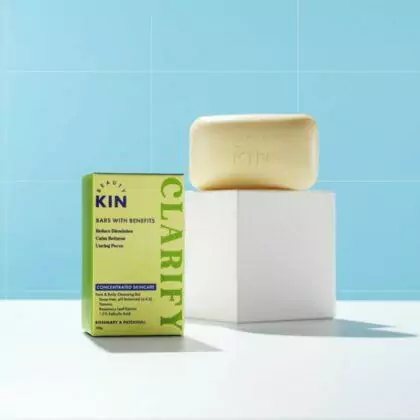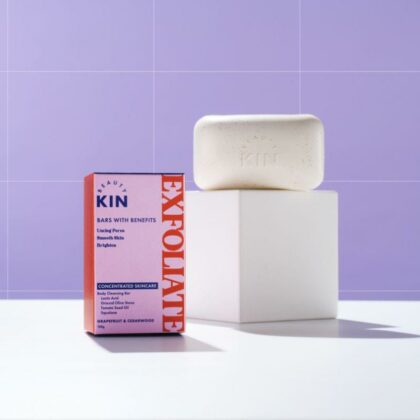As part of acne positivity month we’re breaking down the myths and answering your questions!
What is acne?
Acne is a very common, inflammatory skin condition that can and does occur all over the body. The skin is covered in sebaceous glands, which secrete oil or sebum to stop the skin from drying out. These oil glands are connected to hair follicles, lined by skin cells called keratinocytes. In healthy skin, the sebum emerges from the pore onto the surface of the skin and the keratinocytes come to the surface and are shed.
Acne occurs when sebum, hair, and keratinocytes get stuck in the pore. Therefore, the keratinocytes don’t get shed and the sebum doesn’t reach the surface of the skin. The combination of skin cells and oil means that bacteria that usually inhabit the surface of the skin grow in the follicles and cause redness and inflammation. As the clogged follicle breaks down, the sebum, keratinocytes, and bacteria are released into the surrounding skin, causing spots and lesions. This is what we know as acne.By the way, acne is the same as spots, pimples or whatever else you might call them. It’s simply the term used by the medical profession.
What causes acne?
It’s often thought of as a ‘teenage condition’, but it can affect all ages. The reason it’more prevalent in teenagers is because male sex hormones called androgens are boosted in both boys and girls during puberty. These hormones encourage the production of increased sebum and therefore, puberty is a significant risk for acne. Similarly, hormonal changes during pregnancy and menopause can result in acne breakouts.
There is also evidence of a genetic link for acne, so you may find that other members of your family also have it.
Excessive sweating is another common cause for acne. When sweat sits on the skin for long periods of time, the pores can become clogged and this is especially common on areas such as the back.
The top 6 causes of acne
- Excess oil production
- Clogged hair follicles
- Bacteria in the pores
- Skin inflammation
- Hormonal changes
- Some medications
Medication and acne
Certain medications such as lithium, corticosteroids and hormonal drugs can exacerbate acne flare-ups.
Prednisone, a corticosteroid, is often prescribed to treat inflammatory conditions such as IBS and Crohn’s disease. Along with anabolic steroids, which are used for bodybuilding, they are known to cause acne breakouts. While the reasons are still unknown,some studies think suggest steroids might enhancethe production of immune system receptors called TLR2 (nope that’s not a new Star Wars character) When combined with bacteria that already lives on skin, TLR2 receptors could well bring about a acne attack.
Diet and acne
If you’ve ever gone on a sugar or dairy binge and then realised that your acne has returned with a vengeance, it’s almost certainly not a coincidence. There is growing evidence that suggests that certain foods and diets can exacerbate acne. We know that some foods raise our blood sugar levels quicker than others. The main culprits being sugar, pasta , white bread, rice, generally the processed bad boys.
When blood sugar levels rise rapidly, a hormone called IGF-1 is produced. Excessive amounts of IGF-1 can elevate sebum production and therefore, cause acne. Therefore, it’s highly important to limit these food groups, if you want to keep your acne at bay.
To counteract the high-glycemic food that you certainly shouldn’t be eating excessively, low-glycemic foods include:
- whole grains
- legumes
- unprocessed fruit and vegetables
Due to the lack of simple sugars in these complex carbohydrates, they are highly likely to keep your skin clear while giving you all the energy you need for the day. Some other ingredients that are known to love your skin are:
Vitamin A
Vitamin E
Zinc
Antioxidants
These and other vital minerals for your skin and overall health can be found in:
- spinach and other leafy green vegetables
- tomatoes
- carrots
- sweet potato
- wholewheat bread
- brown rice
- quinoa
- blueberries
- nuts
- beans and lentils
- fatty fish like salmon and mackerel
Consider looking out for the above ingredients and figuring out how you can get as many of these healthy foods into your diet as possible. While we absolutely can’t say that poor diet is a direct cause of acne, there is a lot of science that suggests it’s an aggravator for the reasons outlined above.
Types of acne
Acne comes in varying degrees of severity. You may have some of these symptoms or all of them. However, they are all categorised as inflammation of the skin.
Here’s a list of the most common types of acne:
- Whiteheads, which are closed clogged pores. They lie beneath the skin and present as a white bump.
- Blackheads, which are open clogged pores. They lie on the surface of the skin and look black because of sebum discoloration from the air.
- Papules, which are small red lumps. They can be a bit sore when touched.
- Pimples, which have white pus at the top. They are essentially papules filled with pus, so are red at the base.
- Cystic lesions, which are pus-filled lumps beneath the skin. They can be painful.
- Nodules, which are large lumps under the skin. They are often solid and painful.
All of these types of acne can occur anywhere on the body and outbreaks can severely affect your self-esteem, comfort, and perhaps even your daily activities. Lets take as look at what we can do to help
How can I prevent acne?
If acne has been a resident on your skin since you were a teenager and it’s showing no signs of moving out soon, you’ll be delighted to hear that we have some top tips for helping give it the boot.
Top tips for treating acne
- Use an oil-free, non-comedogenic skin cleanser and moisturiser. Comedogenic means ‘to block pores of the skin’ and most soaps contain ingredients that do this. Our Clarifying body bar is 100% soap-free and perfectly pH balanced, so your pores stay completely clear.
- Rinse your back after washing your hair, especially if you have long hair. Many shampoos and conditioners also feature comedogenic ingredients and can trigger blackhead eruptions.
- Retinoids (containing vitamin A) are used to treat more severe cases of acne.You will need to obtain medical advice as these are generally prescription based treatments.An example of one of these is Tretinoin that works by reducing the shedding of dead skin cells into the hair follicle and reducing inflammation.
- Use cleansing products with salicylic acid. It is known to shrink pimples, remove dead skin cells and eradicate excess oil by drying the skin.
- Be careful not to over-exfoliate. Chemical exfoliants are acne-prone skin’s best friend, as they eradicate dead skin while limiting bacteria production and they cause less irritation than other types of exfoliator.Don’t physically exfoliate!
- Sweat causes clogged pores, so never skip a shower after a workout or after a day in the sun.
- There is a misconception that moisturisers can aggravate acne, but you definitely should moisturise your skin.You just need to make sure that the moisturiser you are using is non comedogenic (won’t clog pores).
We know that acne can be a huge source of pain, embarrassment, and insecurity but it doesn’t have to be. It’s actually incredibly common and at the last count, it was estimated that around 650 million people worldwide are affected by it. Once you know your main triggers, acne can be manageable. If your acne is still severe after your best efforts, a dermatologist will able to help. For now, throw on the backless dress, the vest top and embrace that real skin life!

This article was written for Counter Culture by Nada Ward, founder of Beauty Kin, for more information on the brand check out Beauty Kin’s brand page here.
Check out Beauty Kin’s products for acne here:
-
Beauty Kin Discovery Set
£40.80£23.40 -
Beauty Kin Clarify Bar 100g£9.95 – £23.85
-
Beauty Kin Exfoliate Body Bar£7.95 – £19.05
The British Skin Foundation https://www.britishskinfoundation.org.uk/
NHS Conditions https://www.nhs.uk/conditions/





